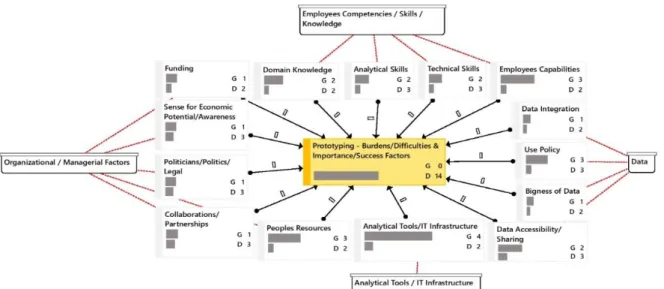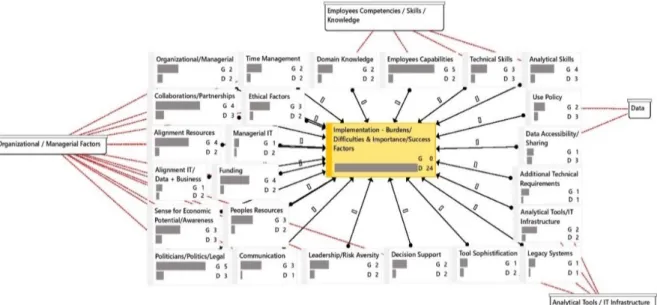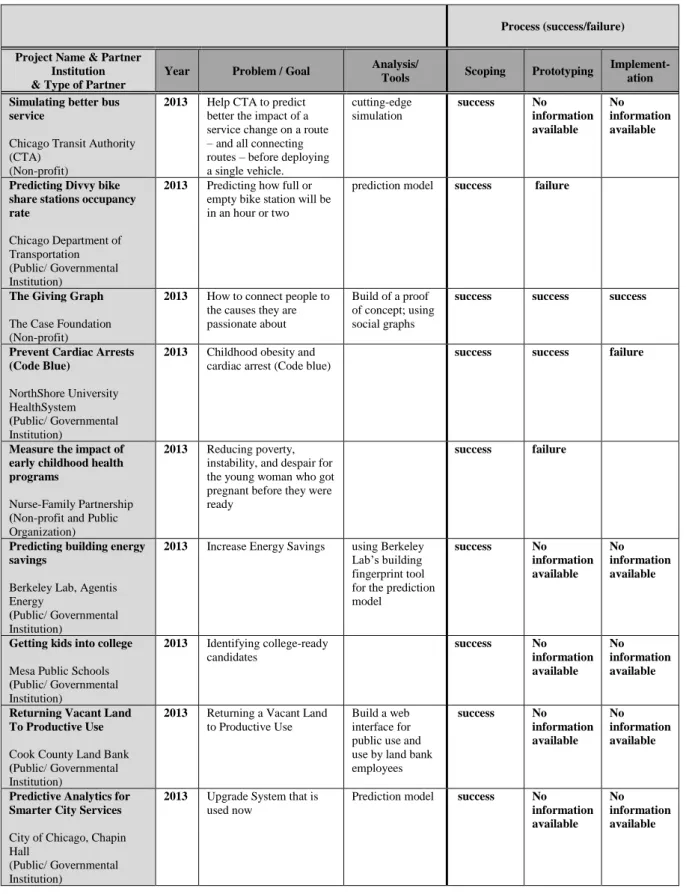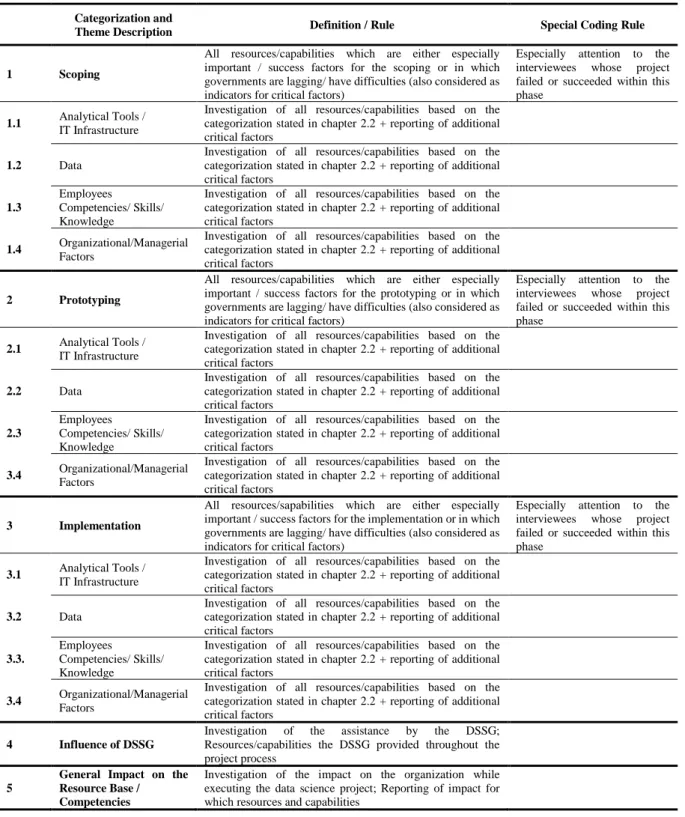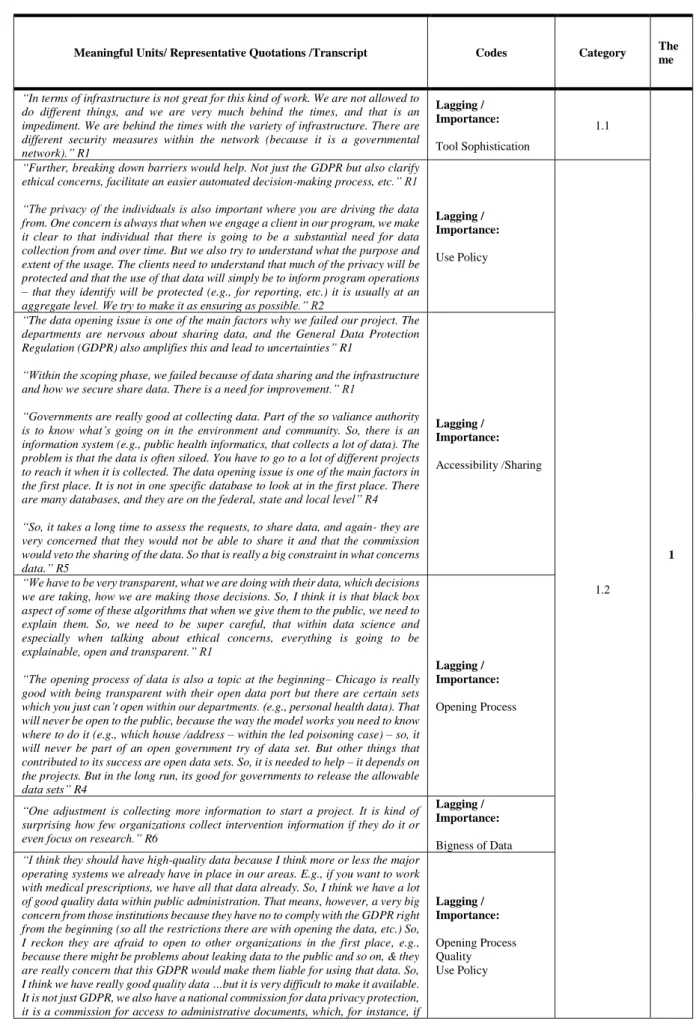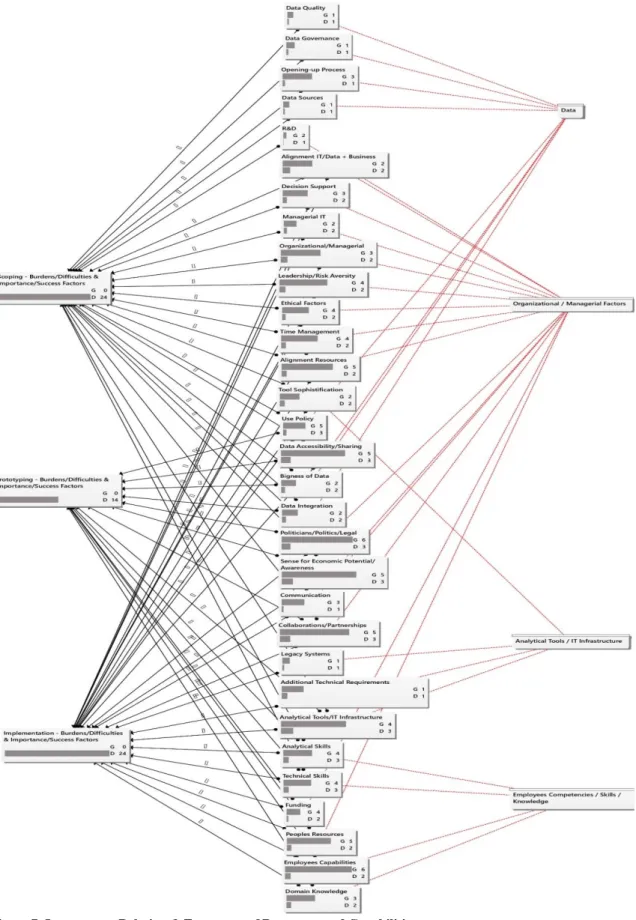A Work Project, presented as part of the requirements for the Award of a Master Degree in
International Management from the NOVA – School of Business and Economics.
Impact and Implementation of Data Science for
Social Good Projects
Jennifer Goerg
Master Student Number: 29935
A Project carried out on the Master in International Management Program, under the
supervision of:
Leid Zejnilović, Ph.D.
2
Title:
Impact and Implementation of Data Science for Social Good Projects
Abstract:
The focus of this study is on assessing the success factors of data science projects within
governmental institutions, as technology laggards, and on investigating the impact of these
projects on these organizations. Using the Dynamic Capabilities as theoretical underpinning,
and qualitative analysis of 6 expert interviews with key informants related to the Data Science
for Social Good fellowship, this study extends the theory by analyzing the projects within
scoping, prototyping and implementation. The findings contribute to the understanding of the
resources and capabilities to execute data science projects in organizations that lack
determinants of success, and impact of these projects.
Keywords (<4):
Dynamic Capabilities, Data Science Resources and Capabilities, Implementation Process,
3
Index
1
Introduction ... 4
2
Theoretical Background and Frameworks ... 6
2.1
Dynamic Capabilities ... 6
2.1.1
Resource-Based View as Foundation for Dynamic Capabilities ... 6
2.1.2
Definitions of Dynamic Capabilities ... 7
2.1.3
Today’s Need for Dynamic Capabilities ... 7
2.2
Data Science Projects ... 8
2.2.1
Resources and Competencies for Data Science Projects ... 8
2.2.2
Data Science in Governmental Institutions ... 10
2.2.3
Burdens for Governmental Institutions ... 11
3
Research Methods ... 12
3.1
Context: The Data Science for Social Good Fellowship ... 12
3.2
Methodological Approach ... 13
4
Findings ... 16
4.1
Scoping ... 16
4.2
Prototyping ... 18
4.3
Implementation ... 19
4.4
Impact on the Organizations ... 20
4.5
Summary of Findings ... 21
5
Discussion ... 22
6
Limitations, Future Research, and Conclusion ... 25
7
References ... 26
8
Appendices ... 29
A.
Excel Sheet – Summary of DSSG Projects (Excerpt) ... 29
B.
Questionnaire Guideline for DSSG Manager and Fellows ... 36
C.
Questionnaire Guideline for DSSG Partner Institutions ... 37
D.
Qualitative Content Analysis of Interviews ... 39
4
1
Introduction
In recent years, the overwhelming daily amount of newly generated data
from the web, human
interactions, and other sources created many new opportunities to rethink how value is created
and appropriated (Kim, Trimi, and Chung, 2014). With the emergence of the phenomenon ‘big
data’ and its possible manifold applications, a newly minted interdisciplinary research field of
‘data science’ is often considered as paradigmatic change or field of power, for its access to
data networks and specific resources but also the expertise to inform and educate (Williamson,
2017). The application of data analytics further profoundly affects organizational culture
(Erevelles, Fukawa, and Swayne, 2016; Kitchin and McArdle, 2015; Fosso Wamba et al.,
2015). Almost every organization in the world make use of data’s potential to improve firms’
outcomes and decision-making processes (Fernández et al., 2014). Although there are studies
that show the possibilities of data analytics to improve decision-making, many organizations
reported lacking results for their investments in data analytics (73%, Colas et al., 2014: 3). Wu,
Buyya, and Ramamohanarao (2016) argue that those organizations lack essential factors which
need to be considered to realize data analytics projects successfully. Colas et al. (2014) provided
a list of resources and competencies, from low quality of data to inadequate analytical skills
(Akter and Fasso Wamba, 2016) while Kim, Trimi, and Chung (2014) further defended that
several challenges, including issues of complexity, security or technology, need to be overcome
in order to obtain the successful usage of data. The surge of investment into data analytics,
despite the challenges, is explained by the potential of data to transform businesses and make
organizations more agile (Harvard Business Review, 2016).
Similar to the way firms are using data science to maximize profits, public organizations started
using data analytics to promote social good, be it a more careful and effective expenditure of
taxpayers’ money, a possibility to address issues of equity in service provision, or transparency
and accountability, among others (Kim, Trimi, and Chung, 2014). During the last years, many
5
organizations launched programs, like the Data Science for Social Good (DSSG) fellowship of
the University of Chicago, to accelerate and support data science projects within governments,
public and non-profit organizations (DSSG Chicago, N/Ab). Mostly perceived as not having
data in its core, operating in low competing environments and lagging crucial resources and
capabilities, governmental institutions require significant support during the transition process
in order to serve the social good (Kim, Trimi, and Chung, 2014).
With the endeavor mentioned above, this paper aims to elaborate success factors of data science
projects in governmental institutions and to assess the impact of executing these projects on the
organizations. Hence, the research gap of analyzed substantial resources and capabilities and
their impact in the transition process of data science projects can be identified, as the novel
concept has previously not gained profound attention within the metrics of science literature.
To address the gap, this paper makes two contributions: (i) The first is a collection and
distribution of critical strategic resources and capabilities within project scoping, prototyping
and implementation. (ii) The second is an examination of the impact on the institutions and an
assessment of organizations’ ability to build Dynamic Capabilities (DC) when executing a data
science project.
The paper starts by introducing the DC Framework based on the Resource-Based View (RBV)
and reviews the essential literature. Afterwards, necessary capabilities and resources from
recent research for data science projects are listed and evaluated. An introduction of data
science for governmental organizations, as well as related burdens and difficulties in this
context, follow. The DSSG fellowship is considered as the empirical example of data science
initiatives and serves as the methodological foundation. DSSG’s partner projects are classified
based on a gradual division of the project’s process and used for qualitative content analysis.
The application of a coding structure for the interviews enables an investigation and alteration
of resources and capabilities and projects’ impact on the organizations. After a presentation of
6
the findings, a concluding discussion about distinctive reasons for a projects’ success and the
impact on the organization’s resources and capabilities comes next. Finally, limitations are
outlined, followed by a brief conclusion.
2
Theoretical Background and Frameworks
The following section is split into two main topics aiming to supply an outline on existing
theories and frameworks which serve as a foundation for the assessment of the previously
described approach.
2.1 Dynamic Capabilities
This chapter describes the underlying framework, relevance, and importance of Dynamic
Capabilities (DC).
2.1.1 Resource-Based View as Foundation for Dynamic Capabilities
Collections of DC conceptualizations are accessible in various managerial studies. In 1997,
Teece, Pisano, and Shuen published a study, which is retrospectively considered as one of the
most influential researches of DC, explaining the framework as an enhancement of RBV
(Barney, 1991). Differences between the underlying resources of the RBV and capabilities of a
dynamic view based on Amit and Schoemaker (1993) are identified in the explanation of
resources as “stocks of available factors that are owned or controlled by the firm,” whereas
capabilities “refer to a firm’s capacity to deploy resources, usually in combination, using
organizational processes, to effect a desired end” (Amit and Schoemaker, 1993: 35). Within the
RBV, organization’s competitiveness is based on unique resources which are rare, difficult to
imitate, and valuable (Barney, 1991). Grant (1991) however classifies substantial resources into
tangible, intangible, and personnel-based. Organizations can be conceptualized as an assembly
of these resources, to create a competitive advantage by implementing new strategies
(Ghasemaghaei, Ebrahimi, and Hassanein, 2018). Without any enlargement, the RBV breaks
7
down when explaining competitive advantages in fast and unpredictable environments (e.g.,
Priem and Butler, 2001) since the duration of competitive advantage is inestimable in times of
digital transformation (Eisenhardt and Martin, 2000). Therefore, the RBV was extended to a
shifting competitive landscape through which a new framework evolved (Teece, Pisano, and
Shuen, 1997).
2.1.2 Definitions of Dynamic Capabilities
Relentless and highly unpredictable changes in a knowledge-intensive time are normalities in
which organizations must demonstrate their capability to cope with environmental and
organizational shifts (Sambamurthy, Bharadwaj, and Grover, 2003). Therefore, the need for
strong DC is notable as they “(…) are simple, experiential, unstable processes that rely on
quickly created new knowledge and iterative execution to produce adaptive, but unpredictable
outcomes” (Eisenhardt and Martin, 2000: 1106). Furthermore, DC are factors by which a
manager can decide to “(…) integrate, build, and reconfigure internal and external competences
to address rapidly changing environments” (Teece, Pisano, and Shuen, 1997: 516). Teece
(2007) distinguishes them into three broad groups of functions, sensing (new opportunities and
threats), seizing (new opportunities through investments) and transforming established
strategies. Barreto (2009) further explained that organizations build DC through a learning
process which cannot be bought, as their development is based on processes which are
themselves determined by the organizations’ assets. Those capabilities are path-depended and
therefore might vary for specific projects. Success or failure of organizations, and therefore
their projects, are a direct consequence of DC (Barreto, 2009).
2.1.3 Today’s Need for Dynamic Capabilities
Being part of the digital transformation, by which the economy is irreversibly impacted,
businesses are increasingly based upon data and have residuated digital processes in their cores.
Therefore, data analytics is a key tool in times of digital transformation (Telegescu, 2018).
8
Digitally born companies, such as Amazon or Google known as the ‘Masters of big data,’
thoroughly exploit data’s full potential in order to realize evidence-based decision-making. By
contrast, throughout various other types of organizations, data still does not have a
decision-making function, even though the potential of (big) data is tremendous and widely acquainted.
Whole markets shift towards their digital reformated selves, and entirely new markets are built
based on emerging technologies. (McAfee and Brynjolfsson, 2012; Fosso Wamba et al., 2017)
Thus, organizations need DC to develop, grow or sustain, while linking digital strategies and
operational business (Fosso Wamba et al., 2017). To survive in this ever-changing environment,
organizations require the ability to sustain by scooping nascent opportunities such as data
science (Lu and Ramamurthy, 2011).
2.2 Data Science Projects
In 2017, Ghasemaghaei, Hassanein, and Turel developed a study to investigate crucial data
analytics resources to execute data science projects. The categories ‘analytical tools’, ‘data’,
‘employee’s capabilities’ and ‘organizational task’, capture substantial factors, and are
therefore employed for the identification of resources and competencies.
2.2.1 Resources and Competencies for Data Science Projects
The generic (big) data analytics capability can be defined as “the ability to acquire, store,
process and analyze large amounts of (health) data in various forms, and deliver meaningful
information to users (…)” (Wang and Hajli, 2017: 290). Prahalad and Krishnan (2002) reveal
additional resources, such as the convergence of business operations and IT. Other studies
support this view, as a strong IT capability advances decision-making, emphasizes a better
reaction to changing environments (Lu and Ramamurthy, 2011) and improves digital strategies,
mainly in synergy with other capabilities (Bharadwaj, 2000; Wang and Hajli, 2017). A
predictive capability emphasizes the diagnosis of the future by establishing models and
estimations out of large data sets to best inform the decision-making (Wessler, 2013).
9
Ghasemaghaei, Ebrahimi, and Hassanein (2018) mention tool sophistication as a key factor,
which is espoused by Bharadwaj (2000), who further declares the quantity of data as an
intangible resource leading to a stimulus of data analytics, which helps to establish insights
about different stakeholders. The DSSG developed the Data Maturity Framework to provide an
assessment possibility for organizations regarding readiness to start tackling social problems
with data science. Data and organizational readiness, integration, as well as data governance,
serve as substantial factors and capture additional important factors themselves, such as
accessibility, policies, and documentation. (DSSG Chicago, N/Aa) Wang, Kung, and Byrd
(2018) indicate that the data governance layer has a prevailing impact on the overall analytical
architecture. Besides, Kwon, Lee, and Shin (2014) mention that the results are especially
dependent on data quality. The human component of domain knowledge and analytical skills
are essential resources that make resources rare, difficult to imitate and valuable (Peteraf, 1993).
Domain knowledge further helps to detect key attributes for more efficient data projects
(Sukumar et al., 2013). Murdoch and Detsky (2013) highlight that the sense for the economic
potential of data analytics is necessary, as a lack of understanding could lead to failures of
projects. In his framework, Bharadwaj (2000) suggests that together with human resources,
managerial IT skills can increase the ability to coordinate multifaceted activities effectively. In
addition, an alignment of IT strategies with an organization’s digital and business strategies
(Galliers, 2011) is a crucial mechanism for a continuously changing environment.
The mentioned papers report the resources and capabilities as critical and valuable for data
science, which can help organizations to sustain and to embed dynamic decision-making
approaches (Ambrosini and Bowman, 2009). Looking at the protruding RBV Framework,
strategic resources alone are not sufficient for a sustainable impact (Braganza et al., 2017).
Therefore, strong DC should be a high priority, as R&D also reveal further application
possibilities for data science (Wernerfelt, 1984). Table 1 summarizes the mentioned resources,
10
capabilities, or critical factors related to data science from recent studies, based on the
categorization by Ghasemaghaei, Hassanein, and Turel (2017).
Table 1: Research Summary of Data Science related Resources and Capabilities
Category Important Resources/ Capabilities
Studies Analytical
Tools/IT Infrastructure
Big Data analytics competencies Wang, Kung, and Byrd, 2018; Telegescu, 2018 Predictive capability Wessler, 2013; Wang, Kung, and Byrd, 2018
Tools sophistication Bharadwaj, 2000; Ghasemaghaei, Ebrahimi, and Hassanein, 2018
Data
Sources Wang and Hajli, 2017
Governance Wang, Kung, and Byrd, 2018; DSSG Chicago, N/Aa
Quality Bharadwaj, 2000; Kwon, Lee, and Shin, 2014; DSSG Chicago, N/Aa
Bigness Bharadwaj, 2000
Accessibility DSSG Chicago, N/Aa
Aggregation layer/storage Wang, Kung, and Byrd, 2018; DSSG Chicago, N/Aa
Integration DSSG Chicago, N/Aa
Documentation DSSG Chicago, N/Aa
Use policy DSSG Chicago, N/Aa
Employees Competencies/
Skills
Analytical skills Bharadwaj, 2000; Wang and Hajli, 2017; Waller and Fawcett, 2013
Technical IT Bharadwaj, 2000
Domain Sukumar et al., 2013; Bharadwaj, 2000; Waller and Fawcett, 2013
Organizational /Managerial
Factors
Sense for the economic potential of data analytics
Murdoch and Detsky, 2013 Alignment between IT/data and
business strategies
Galliers, 2011; Reich and Benbasat, 1996 Alignment of resource
commitment and strategy
Smith and Lewis, 2011 Decision support capability Wang, Kung, and Byrd, 2018 Managerial IT skills Bharadwaj, 2000
R&D Wernerfelt, 1984
People resources DSSG Chicago, N/Aa
Leadership DSSG Chicago, N/Aa
2.2.2 Data Science in Governmental Institutions
Within an always changing momentum of technology, it is crucial to investigate which greater
purpose data science can serve and how a meaningful impact can be achieved, by solving
real-life problems. Not just private but also public institutions are increasingly aware of the urge to
use data to understand their citizenry, mainly to implement effective interventions, policies or
improvement of projects. (Kim, Trimi, and Chung, 2014) Necessities to manage the public good
(Archenaa and Mary Anita, 2015), such as solutions for water or air pollution are frequent cases
for which governmental institutions rely on (big) data to increase their impact (Venkatram and
Geetha, 2017). Wang and Hajli (2017) disclose several benefits to reveal the reasons for the
usage of data analytics, from IT infrastructural benefits, such as the reduction of system
redundancy, to organizational and managerial benefits, such as insights about emerging trends.
However, governmental institutions face burdens and difficulties when adapting their resources
11
and capabilities towards a data-driven approach in order to receive the benefits (Kim, Trimi,
and Chung, 2014). The MIT Sloan Management Review published a comparison of different
sectors about their status quo of resources and capabilities for digital technologies. As the
second least sector in data maturity, the federal public sector performs rather poorly within all
selected digital qualities, such as leadership skills. (Kane et al., 2015)
2.2.3 Burdens for Governmental Institutions
Similar to the categorization of essential factors, burdens appear related to the given
dimensions. Within the analytical tools and IT infrastructure category, governmental
institutions possess difficulties, such as open-source software issues (McAfee and Brynjolfsson,
2012). Experiences show that sharing data is considered a significant challenge, since
governmental institutions, as well as partnerships, usually incorporate cross-border information
flow. Tools to enable language transformation and interpretation of semantic and sentiment are
often costly or are missing entirely. Similar problems occur when governmental institutions
need business data sets which discern in scope and scale compared to the governmental
data-sets. (Kim, Trimi, and Chung, 2014) Within the category data, the ‘three V’s’ characteristics
from big amounts of data are often challenging. Especially governments are struggling because
the volume of data needs to be in line with its regulations, the velocity causes challenges for
conventional IT with the speed of the data (Ohlhorst, 2013) and the variety often requires
several new technologies. (Kim, Trimi, and Chung, 2014) Public organizations tend to keep
their data close, as critics might occur after providing the society with new insights. Burdens
are the often missing opening processes and subsequently the necessity for new monitoring and
responding mechanisms. (Janssen, Charalabidis, and Zuiderwijk, 2012) Furthermore, Kim,
Trimi, and Chung (2014) mention the collection of data, coming from different channels (e.g.,
crowdsourcing), various sources (e.g., countries, agencies, departments) in numerous formats
and with entailed costs as obstacles. Data collection and usage issues are challenges, as privacy
12
rights often obstruct data analysis. Main technology approaches, such as open source or
commercial implementations can cause difficulties, rooting from the severity of the usage to an
expensive price level or specialized skill-sets of employees. (Kim, Trimi, and Chung, 2014)
Related to this, difficulties within employees’ capabilities are reported, as dealing with data
science requires new skillsets accelerated by the rareness of crucial expertise, e.g., for data
cleaning and organizing, as well as for the design of testing and prototyping (McAfee and
Brynjolfsson, 2012). Governmental organizational/managerial processes also involve
difficulties like the management of legacy systems (McAfee and Brynjolfsson, 2012) or funding
scarcity (Kim, Trimi, and Chung, 2014). A usually profound organizational history of
governmental institutions molding the culture leads to a laborious and far-reaching adaptation
process of new technologies (Cianni and Steckler, 2017; Fosso Wamba et al., 2017). Moreover,
extensive decision-making processes are based upon the duty to incorporate several parties
(Stone, 2002). As organizations aim for agile processes and faster-paced decision making, it
can be determined which resources and capabilities, such as regulations, run counter to the
behaviors they are trying to instill (Cianni and Steckler, 2017; Fosso Wamba et al., 2017).
3
Research Methods
To investigate the described theoretical background and to set it into practice, the DSSG
fellowship serves, together with its partners’ projects, as the foundation for this analysis.
3.1 Context: The Data Science for Social Good Fellowship
The DSSG aims to train fellows to support public or non-profit organizations in areas such as
health, public safety, economic development and education with the application of data science
(DSSG Europe, N/Aa). Therefore, the DSSG developed an annual 12-weeks summer
fellowship, which has supported 64 projects since 2013 (see Appendix A) (DSSG Chicago,
N/Ab). In 2017, the University of Chicago started a cooperation with the Nova School of
13
Business and Economics in Lisbon to build up a second location for the fellowship (DSSG
Europe, N/Aa). Besides others, machine learning or artificial intelligence are tools which are
used to tackle social problems, such as high unemployment rates in Portugal, where fellows
developed a dynamic-modeled system to allocate resources better and to indicate risk factors
for unemployment (DSSG Europe, 2018; DSSG Europe, N/Aa).
The fellowship begins with the approach of the organizations, followed by an extensive scoping
process. Until today, several hundred projects started the scoping process based on criteria such
as the comprehensiveness of impact, the availability of data, as well as the organizational
readiness to be biased for action (DSSG Chicago, N/Aa). If the collaboration further continues,
the prototyping phase begins, which is primarily supported by the DSSG. The fellows develop
a prototype and aspire to open the developed algorithms in order to sustain the codes by the
reuse of others. The organizations themselves are responsible for the implementation of the
projects, sometimes with the help of implementation partners and fellows. (DSSG Chicago,
N/Ab) Several projects have not been implemented, and various others have not been continued
during the fellowship (see Figure 1). Therefore, an assessment of factors to succeed in
developing data science projects may help organizations to build the required capabilities and
deliver these projects for social good.
3.2 Methodological Approach
For this study, a typical data science project is considered to traverse the phases of (1.) scoping,
(2.) prototyping and (3.) implementation (Fritzler, 2015). Possible outcomes of a project are
either a success or a failure at any of the phases. Projects which succeeded or failed in a later
stage, succeeded by default in previous stages (see Figure 1). For this analysis, success is
defined as a project which reaches the next phase, whereas failure is considered as a project
which is not continued. Success in the implementation phase signifies the institutionalization
of a project.
14
A summary list of all DSSG projects has been made, with information about the problem
formulation, solution approach, organization type, and applied analysis tools. An excerpt of this
list is attached in Appendix A, Table 3. However, only those partners who successfully scoped
their projects are listed. Afterwards, the projects have been categorized as a success or failure
within the phases (1.), (2.) and (3.), with the help of Rayid Ghani (Director of DSSG Chicago),
Joseph Walsh (Data Scientist at DSSG Chicago) and Leid Zejnilović (Director of DSSG
Europe). Note that although some projects are categorized as a failure, success of a project
could also be understood as “the help for the social good, inspiration of people for the future,
training of the partner and fellows, etc. Not all projects need to possess all the given factors in
order to be successful in some kind” (R6, p.54).
The papers from Wiesche (2017) and Harrison et al. (2016) constitute a foundation for the
explanation of the methodological approach. As a qualitative inquiry, this research aims to be
a comprehensive and holistic investigation in the area of data science. The objectives are the
DSSG fellowship and its partners, while the boundaries are the selected organizations out of all
partner organizations during the last six years. The scope follows a multi-case sampling
approach as the study includes insights from different potential outcomes. The exploration of
unique new resources and competencies, as well as an evaluation of existing research-based
variables, embedded in the theoretical DC Framework, can be described as the design of the
study. Semi-structured interviews based on questionnaire guidelines (see Appendices B, C),
which lasted approximately 45-60 minutes, served as the main data collection process. The
interview partners were sampled out of the universe of potential outcomes (see Figure 1).
Together with two expert interviews with a DSSG member and a governmental advisor, the
interviews with DSSG partner organizations capture knowledge from inside and outside
organizations. The categorization as either a success or failure within their specific phases, the
involved knowledge of previous process phases, as well as the goal to maintain an openness
15
during the interviews, led to individually adjusted guidelines. The interviews were recorded and
transcribed.
Figure 1: Outline of Data Science Project Stages with DSSG’s Projects Numbers and Interviewees (derived from information in Appendix A): The outcomes ‘success’(s) and ‘failure’(f) are illustrated within the three phases, together with the total number of projects in each phase, the number of governmental institutions (in brackets), the number of interviewed organizations (Int.) as well as the interview partners:
* = Jamie Stainer, Principal of the Youth Training Statistic and Research Branch, Department for the Economy of the UK, (Respondent: R1)
** = Bill Thorland, Director of Evaluation and Research, Nurse-Family Partnership (Respondent: R2) ***/*/* = Tin Oreskovic, Partner for Croatian Institute of Public Health (Respondent: R3)
***** = Raed Mansour, Director, Chicago Department of Public Health (Respondent: R4)
In addition to those: Rui Lourenco, Technical Advisor, Republic of Portugal (Respondent: R5) and Joseph Walsh, Data Scientist, Center for Data Science & Public Policy & DSSG (Respondent: R6)
The analysis model of the results is based on the systematic approach of grounded theory
methodology, as it is suitable for researches in the field of technological change (Wiesche,
2017). This research encompasses the explanation as a description of factors within the area of
data science in governmental institutions. Therefore, this type of research can potentially be
defined as a theory. After an analysis of the interviews (see Appendix D) the processes of open,
axial and selective coding, combined with a constant comparison, follow (Wiesche, 2017). To
capture a firms’ resource and capability base, labels such as ‘tool sophistication’ or ‘technical
skills’ are assigned to collect information during an open coding process. A closer investigation
of collected data is done during the axial coding, while sub-themes such as ‘IT infrastructure’
or ‘employee’s capabilities,’ similar to those mentioned in the theoretical background, are
identified. The themes ‘scoping,’ ‘prototyping’ and ‘implementation’ are built during selective
coding, and related codes and sub-themes are categorized accordingly. In Table 4 (see
Appendix D) corresponding coding rules and descriptions are explained, followed by Table 5
(see Appendix D), which illustrates the corroborating evidence quotes from the interviewees.
3.
Implementation
2. Prototyping
1. Scoping
> 100 application per year s: 64 (41) s: 52 (33) 1 Int.*** s: 12 (7) 1 Int.***** f: 24 (12) 1 Int.**** f: 6 (3) 1 Int.** f: 1 Int.*16
Finally, a comparison of codes, sub-themes, and themes (Wiesche, 2017), reveal the similarities
and differences between the necessary resources and capabilities during a data science process.
Figures 2, 3 and 4 are designed to illustrate the coding structures and to highlight the results of
importance and relation between resources and capabilities to the three project phases. The
figures show the frequencies of resources or capabilities mentioned by the interviewees (‘G’
(max. = 6)) and the density of correlations (‘C’), whereas Figure 6 (see Appendix E)
demonstrates the overall relations and coding structure. The results are derived from the
analysis in Table 5 (see Appendix D). Resources and capabilities which are not listed in Table
1, are classified as substantial additional factors and are clustered to their respective category.
To access the most important resources and capabilities in each phase and to compare the phases
accordingly, the frequency of mentioned resources and capabilities is set to a cut-out value of
‘G >= 2’ for a summary of findings. This summary of resources and capabilities is derived in
Table 2, together with the impact on organizational resources and capabilities.
4
Findings
Categorized in the phases (themes) of a data science project, the content analysis has led to the
following findings and is based on the recognition that the resources and capabilities, as well
as the burdens and problems mentioned in chapter 2.2, are critical factors of a project.
4.1 Scoping
Achieving success in the scoping phase is the first critical step to develop a data science project.
Jamie Stainer of the Department for the Economy of the UK, whose DSSG project failed for
several reasons, states that “the data opening issue is one of the main factors why we failed our
project. The departments are nervous about sharing data, and the General Data Protection
Regulation (GDPR) also amplifies this and lead to uncertainties” (R1, p.40). He further
mentions aspects like unavailable infrastructure, data sharing burdens, data securing issues and
17
missing human skills to cope with the burdens (R1, p.40-42). Figure 2 demonstrates the overall
results for the scoping phase and reveals especially the importance of resources within the
category ‘data,’ compared to the following phases (see Figure 3, Figure 4). Besides the opening
process, use policies and data accessibility issues are essential factors as those are mentioned
in three out of six interviews. The opening process of data, data quality, sources, and
governance are solely mentioned within the scoping phase, validating the importance of the
category ‘data’ (see Figure 2). Raed Mansour, Director of the Chicago Department of Public
Health, states that “(…) the problem is that the data is siloed. (…) There are many databases,
and they are on the federal, state and local level” (R4, p.40). ‘Opening up of data,’ ‘collaboration
and partnerships,’ ‘time management,’ ‘ethical factors’ as well as ‘political factors’ are vital
resources which are not mentioned in the elaborated list in chapter 2.2.
Figure 2: Scoping: Importance, Frequency & Relation of Resources & Capabilities from the Interviewees (p.40-41): The figure reveals all resources and capabilities which are reported as substantial factors within project scoping by the interviewees. All four categories are present, while especially ‘data’ and ‘organizational/managerial factors’ indicate a high influence for success.
Furthermore, the abundance of sources and administrative difficulties to effectively deal with
the data is mentioned (R3, p.43). Some managerial factors are rated as especially important as,
e.g., four out of six experts report politics and legal regulations (see Figure 2). IT infrastructure,
18
as well as technical and analytical skills, are listed, even though they do not show high
importance (see Figure 2). The DSSG assists the organizations during the scoping process with
data revisions or general managerial resources (R3, R6, p.51).
4.2 Prototyping
The partner project ‘Nurse-Family Partnership’ failed within the prototyping phase and its
expert, Bill Thorland, mentions that especially infrastructural resources, skillsets, and talent
(R2, p.44) are missing to pursue new (machine learning) approaches (R2, p.43). The project of
the Croatian Institute of Public Health succeeded within prototyping, and its expert, Tin
Oreskovic, states that “(…) many departments and people are getting involved. The technical
infrastructure is crucial, and stakeholders need to be convinced that the project is useful” (R3,
p.43). The general results, illustrated in Figure 3, display that the importance of data related
factors decrease, while IT infrastructure (4 out of 6 interviewees), people resources (3/6), and
their skills and knowledge (e.g., general employees capabilities (3/6), domain knowledge (2/6)),
increase compared to the scoping phase. The expert corroborates this, stating that “(…) there is
a need for people focusing on the project during the development as they are often buried with
regular report work” (R3, p.44). Funding is reported as an additional factor to the list from
recent research in Table 1. The DSSG makes it to its business to strengthen the organizations
with at least doubling their resources regarding data analysis during prototyping (R2, p.52). It
supports the provision of resources and capabilities throughout all four categories, such as
technical analysis and the establishment of predictions (R3, p.52).
19
Figure 3: Prototyping: Importance, Frequency & Relation of Resources & Capabilities from the Interviewees (p.43-44): The figure reveals all resources and capabilities which are reported as substantial factors within project prototyping by the interviewees. All four categories are present, while especially ‘analytical tools and IT infrastructure,’ ‘data’ and ‘employees’ competencies/skills/knowledge’ indicate a high influence for success.4.3 Implementation
Within the last process step, several DSSG’s partner projects succeeded and have been
implemented (see Appendix A, Table 3). The expert Raed Monsur declares that “there are a lot
of policies throughout all departments, which we needed to bypass when implementing the
project (e.g., wage structure)” (R4, p.47). Related to this, analytical skills and additional
employees’ capabilities are critical as “(…) it is rather difficult to create the kind of skills which
provide governments with the opportunity to participate, maintain and continue with data
science projects” (R5, p.47). Figure 4 depicts the results of the implementation process and
emphasizes the importance of collaborations and partnerships together with the alignment of
resources (4/6 experts). Furthermore, the interviewees reveal the importance of funding as
governmental institutions are mostly driven by grants, which increase the number of influencers
for decision-making (R4, p.51). Within the implementation phase, additional factors like ethical
concerns and communication gain importance (see Figure 4) and the factors legacy (IT)
systems, additional technical requirements and communication between the departments are
introduced, which enlarge the resource and capability list from recent research (see Table 1).
Figure 4 highlights notably the increased influence of organizational/managerial factors and the
20
importance of employee’s competencies. Data related factors decline remarkably in concern of
its importance compared to prior phases. Besides, various analytical or IT infrastructural factors
are mentioned, however with a low priority (e.g., tool sophistication (1/6)). During the
implementation, the DSSG supports additionally with managerial resources (R3, R6, p.52).
Figure 4: Implementation: Importance, Frequency & Relation of Resources & Capabilities from the Interviewees (p.46-51): The figure reveals all resources and capabilities which are reported as substantial factors within project implementation by the interviewees. All four categories are present, while especially ‘organizational/managerial factors’ and ‘employees’ competencies/skills/knowledge’ indicate a high influence for success.
4.4 Impact on the Organizations
To realize data science projects, organizations firstly need resources and capabilities but are
often also able to build up new, reconfigure old or learn upon resources and capabilities. Figure
5 reveals factors which are impacted and improved by the execution of a data science project
according to the interviewees. Among the improvements in the communication are factors such
as the alignment between organizational departments and awareness for the various possibilities
of data science (e.g., R5, p.50). Also, executing a project leads to the development of processes
and factors not explicitly identified in the literature review or the improvement of resources and
capabilities mentioned in Table 1, such as the ability to standardize processes in order to build
sustainable processes (e.g., R4, p.53), the improvement of data integration and the increase in
data accessibility (e.g., R3, p.54).
21
Figure 6: Impact: Importance & Relation of Resources & Capabilities to the Data Science Project Process (p.52-54): The figure reveals resources and capabilities which are reported as impacted while executing a data science project in governmental institutions by the interviewees. Especially ‘organizational/managerial factors’ are profoundly impacted by the execution of a project.The content analysis shows that the DSSG is furthermore an influencing factor, enhancing the
positive impact of data science on the organizations. As the investigated organizations are
partners from the fellowship, they benefit from sustained impact with, e.g., increased sensitivity
for economic potential (R1, p.52) or the need for breaking siloed databases (R4, p.53).
4.5 Summary of Findings
To identify the most pressing factors, the cutoff values for the frequency of reported resources
and capabilities in project scoping, prototyping and implementation are set to ‘G>=2’. Next,
each of the resources and capabilities that satisfy this condition in Figure 2, 3 and 4, are
represented side-by-side in Tabe 2. Further, the table indicates those resources and capabilities
which have positively been impacted by the execution of a data science project.
Table 2: Most pressing Data Science related Resources and Capabilities and Impact of the Process
Category Important Resources/ Capabilities Scoping Prototyping Implemen-tation
Impact Analytical Tools/IT
Infrastructure
Big Data analytics competencies Predictive capability
Tools sophistication
General analytical tools/IT infrastructure • •
Data Sources • Governance Quality Bigness Accessibility • • • Aggregation layer/storage Integration Documentation Use policy • • •
22
Addition to Table 1 Opening process •
Employees Competencies/ Skills
Analytical skills • • •
Technical IT • • •
Domain • •
General employees’ capabilities • • •
Organizational /Managerial
Factors
Sense for the economic potential of data analytics
• • •
Alignment between IT/data and business strategies
• Alignment of resource commitment and
strategy
• •
Decision support capability • •
Managerial IT skills
R&D •
People resources • • •
Leadership • • •
General organizational/managerial factors • •
Addition to Table 1 Politicians/politics/legal • • Time management • • Collaborations/partnerships • • • Ethical • Communication • • Funding • Additional Factors and Processes influenced by the Execution of Data Science Projects Innovation processes • Sustainability of projects • Flexibility in projects • APIs • Services of organizations • Persistence of projects • Standardized processes •



